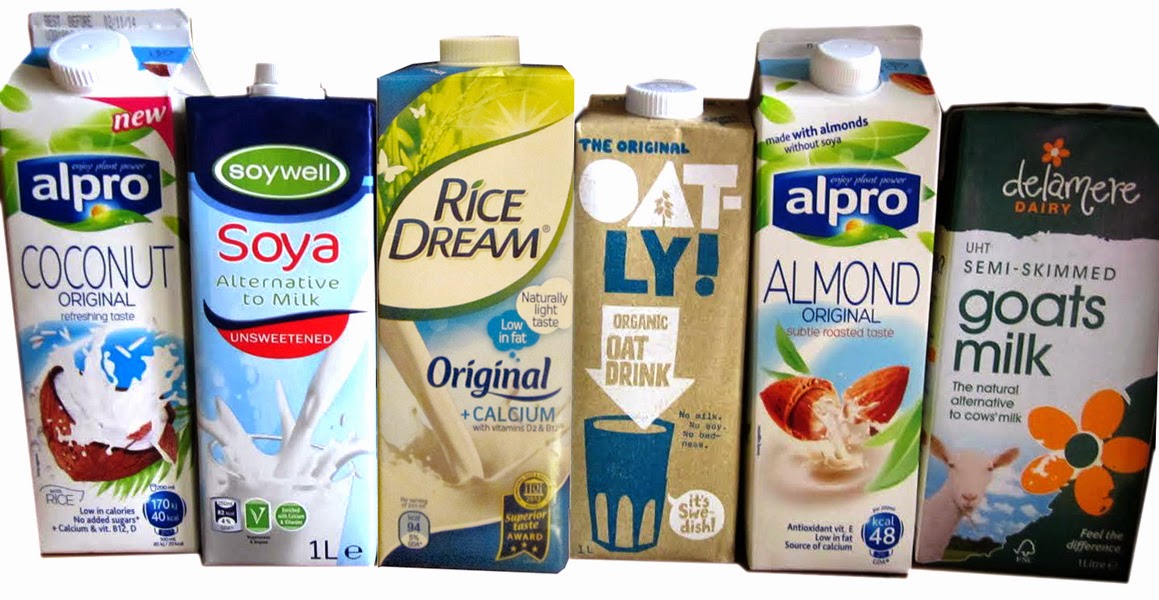No milk today - lacking the lactose
If the New year has prompted you to improve your health, you
may be considering going lactose free as well as gluten free.
A lactose free diet may help in reducing indigestion problems
– some of established symptoms of lactose intolerance are listed here.
http://www.nhs.uk/Conditions/lactose-intolerance/Pages/Introduction.aspx
If lacto-free suits you, there are a vast array of sweetened
and unsweetened, organic or flavoured options to try.
The Barefoot Contessa’s advice to ‘buy half a
dozen, stick with the one you prefer’ springs to mind but we can’t all afford
to do that and who will drink the one you think is yuck? It’s hard to find time to stand in shopping aisles
squinting at labels before making an informed decision and even online labels
are a chore to compare. So here are our general
findings as a short cut - we hope this helps point you in the right direction…
Lactose free cow’s milk
Of course there are lactose free versions of cow’s milk,
easily available in the supermarkets, and this may be the simplest and first
alternative to try! This way you can keep the full fat and calcium aspects of
milk in the diet, particularly important for children. Also no need to alter your usual milk and
cheese based recipes
Goat's milk
 |
| Telling the difference - between milk and 'milk' |
Goat’s milk is also readily available, and many people are
more tolerant of goat’s milk. Delamere long life goat’s milk is convenient to
have in storage. Once opened, keep refrigerated and use within 3 days.
Goat’s milk can be used exactly as cow’s milk in
recipes. It looks pure white and of a
good consistency, only slight milky smell but does taste different to cow’s
milk straight – more savoury if anything.
Some people find this off- putting on cereals etc (often children do)
but it is barely noticeable in cooking (pancakes made with goats milk pass the
kid test!)
Soya 'milk'
People often opt for soya milk as the most easily obtainable
alternative to milk. Of course this is derived from soya beans so if you are
avoiding pulses best to opt for an alternative.
Health wise Soya has its pros and cons, may be good to check out the
health benefits before switching.
The brand we have
found most tasty and really good value is available from Lidl, Soywell
unsweetened soya milk (there is a sweetened version). It is creamy beige in colour, as with most
soya milks you need to shake before pouring but has a good consistency. It smells a little plant like and has a
slightly nutty taste which is well rounded in tea. You cannot use soya milk in coffee – it curdles
– but it is ok on cereal or as hot chocolate.
Does not make very good pancake batter or smoothies, they do not pass
our ‘kid test’ in taste or consistency.
Once opened, keep refrigerated and consume within 3 days.
Coconut 'milk'
I love the taste of coconut, so I really like this milk! We
already cook with coconut oil so this is a useful addition in some
recipes. We use Alpro coconut milk,
widely available. It pours very white, quite
smooth, less thick than full fat milk but definitely no 'gloopiness'. It smells mildly of coconut and tastes slightly
of sweet coconut which very refreshing. It has no added sugar which is a definite bonus! It tastes great on cereals and muesli, as a
drink, in smoothies, and of course in Thai curries. (There is some added rice to this version.)
Oat 'milk'
If you are not completely gluten free, this is a good
possible alternative. Oatly milk alternative is Swedish, made entirely from
oats and water with a little sea salt (with no added sugars) and there is an
organic version. It is easily available in most supermarkets. As it says on the label, you have to shake
before every pouring. It is pale cream
in colour, does not smell of much, and actually tastes lovely – quite sweet
almost like Horlicks. Great to make
porridge with, or on muesli, (of course) or to make drinking chocolate. Once
opened, keep refrigerated and consume within 5 days.
Almond 'milk'
I was quite keen on the idea of an almond milk as almonds
are so good for you. However, I was
disappointed in the Alpro almond milk which we tried. It has so much added sugar! Sugar is higher up on the ingredients list
than almonds (only 2% almonds in the recipe) so this would not be a very good
staple if watching your weight or GI. You need
to shake before pouring but does have a good consistency and is creamy
looking. Smells subtly of almonds,
tastes nutty but rather too sweet for our tastes - good perhaps for smoothies,
shakes or on cereals if you have a sweet tooth and are not cutting out sugar
from your diet. Please note that Alpro have recently launched a no-added-sugar version that was unavailable for our taste test - still only 2% almonds.
Rice 'milk'
Rice milk is a gluten free alternative and can keep
refrigerated for up to 7 days, useful if you are the only one using it! We tried Rice Dream, which won an ’itqi' superior
taste award in 2012. It is white, smells
vaguely of rice and needs shaking before pouring. Has thinner consistency than full fat milk
but tastes sweet and pleasant, though a little rice like! Good with cereals. There is no added sugar but still tastes
sweet and would be good for people who like the taste of cow’s milk. There is added sunflower oil which may alter
the omega 3 balance of your diet.
I hope these notes help you make an informed choice of the
best lactose free alternatives which suit your diet – happy hunting!


Comments
Post a Comment